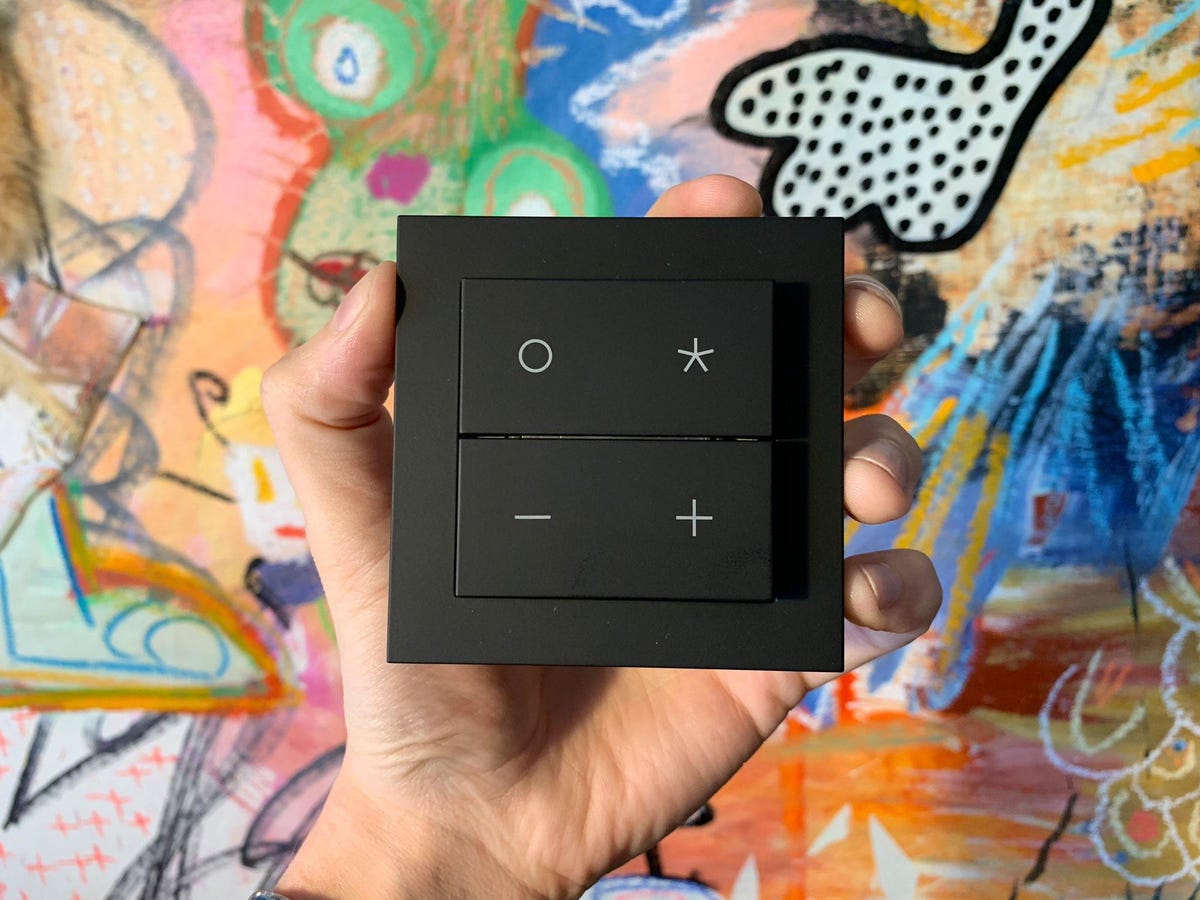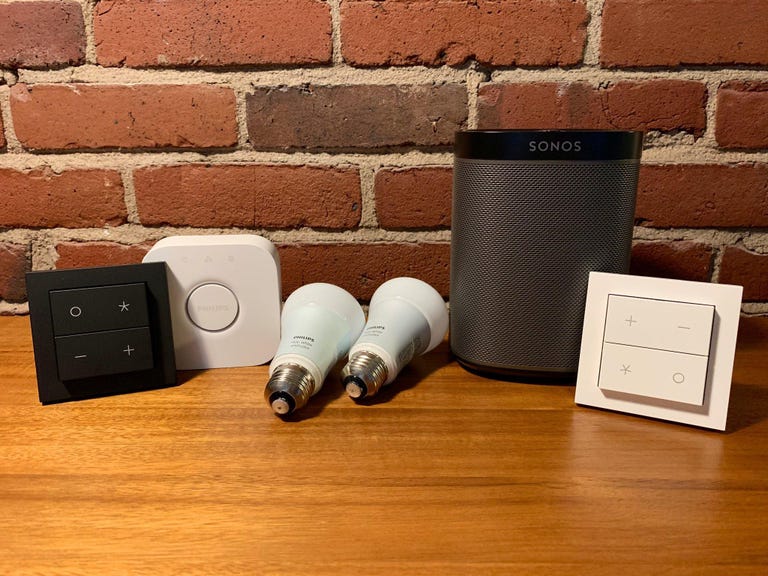 Why You Can Trust CNET
Why You Can Trust CNET Senic Nuimo Click Starter Kit review: These buttons need no batteries to control Sonos and Hue
They don't come cheap, but the self-powering Nuimo Click wireless remotes are a simple, elegant way to control your Philips Hue smart lights and Sonos smart speakers.
When it comes to home automation, voice controls are all the rage these days -- but there's still plenty of appeal left in the good ol' magic button approach.
The Good
The Bad
The Bottom Line
Enter German smart home manufacturer Senic. The company makes fancy-looking, "Nuimo"-branded wireless remotes for your smart home gadgetry. The newest offering, available for preorder now, is the Nuimo Click. At $229 for a two-switch starter kit (about £180 or AU$320, converted roughly), the Click is a four-button remote for Philips Hue smart lights or Sonos smart speakers that uses a nifty trick to power itself through your very button presses. That means it doesn't need any batteries and won't require you to recharge it -- ever.
$229 is quite a lot to spend for a pair of push-button remotes, each of which can only be paired with one device or group of devices at a time. For comparison, the Philips Hue Tap, a wireless four-button remote for Hue lights that uses the same self-powering tech as Nuimo, costs $50 each. If you're just looking for a smart, bedside light switch for your Hue bulbs, it's the much better way to go.
The Logitech Pop smart button costs a lot less, too -- it isn't self-powering, but it can control Sonos and Hue gear, plus a whole host of other kinds of devices, and it works with Apple HomeKit, too. Heck, if you're an Alexa user, you could even turn your lights off by picking up a pair of Echo Buttons for a total of $20.
Still, Senic's switches look awfully classy, and the Sonos and Hue controls worked as advertised when I tested them out at the CNET Smart Apartment. If you like the design, you use both Hue and Sonos products in your home, you value simplicity, and -- most importantly -- you don't mind splurging, then they're worth a look. However, for most of you, I think there are other, more cost effective solutions that'd be a better fit.

The push of a button
A little smaller than a drink coaster, each Nuimo Click is a lightweight piece of polycarbonate with a clean, minimalist design. With roughly a half-inch bezel around the buttons themselves that doesn't seem to house any of the actual hardware, they're a little bigger than they probably need to be, but they still feel fine as handheld remotes. Thanks to the matte finish, they don't feel too plasticky, either.
The buttons themselves have a stiff, "clicky" feel to them, but not so much that they're difficult or uncomfortable to use. With proprietary energy harvesting technology from a company called EnOcean packed inside, each of your button presses provides the power needed to send the Click's signal to the Nuimo Hub, which will in turn relay your command to your home's router via Wi-Fi and then on to your Philips Hue Bridge or Sonos speakers.
Mind you, I didn't notice any lag with any of that as I tested the things out. Press a button, the music plays. Press a button, the lights dim. Even when I stress tested each Click's maximum range of 30 meters, they worked flawlessly. Add in the convenience of never needing to replace or recharge a battery, and you can start to see the appeal of these switches.
Available in white or black, they look and feel like premium devices, which is appropriate given what you'll need to spend for them. $229 gets you the two-switch starter kit that comes with the hub -- after that, each additional Click is a slightly more reasonable $69 each. Still pretty steep by my standards.
Here’s a video of those controls in action. Seems very snappy and responsive. Note that you can press both right buttons to switch to a random color, or both left buttons to return to white. pic.twitter.com/RGQ8CF85YW
— Ry Crist (@rycrist) November 27, 2018
Super-simple setup, excellent ease of use
Getting started with the Nuimo Click switches is a total snap. Just download Senic's app and follow its clear, simple instructions. Plug the Hub into power, and it'll use Bluetooth to pair with your phone almost instantly. Provide your Wi-Fi password to connect it with your home network. Scan for your Sonos and Hue devices, then pair the switches themselves by pressing a four-button sequence on each one. Assign a device or group of devices to each switch, and you'll be ready to go.
The Hub gets a little bulky with the EnOcean dongle plugged into its USB port. I wish Senic had just incorporated that EnOcean radio into the Hub to begin with.
Speaking of ease of use, I also appreciated that the Hub doesn't need to be wired to your router with a LAN cable (though it does have a LAN port, and Senic says that the option to hardwire it to your router is coming soon). The non-wired approach lets you put the Hub anywhere in your home that you like -- that's especially nice since the bulky EnOcean dongle that you'll need to keep plugged into its USB port makes it a little too cumbersome for a crowded router shelf.
The plus and minus buttons on each switch will dim or brighten the lights if you're using it to control Hue gear. With Sonos, they'll adjust the volume. The circle is an on/off button for Hue and a play/pause button for Sonos. The star cycles between your choice of three Hue lighting scenes or three My Sonos playlists.
You can also press the two buttons on the left or right simultaneously -- with Hue, the left buttons make the lights white while the right buttons change them to a random color. With Sonos the left buttons skip to the previous track, while the right buttons skip to the next one.
All of it is easy and intuitive, and again, it just works. Only once or twice during my tests did a button press fail to register, and that was only when I was stress testing my Hue switch by toggling the lights on and off about once a second.
Perhaps too simple?
The simplicity of the Senic app borders on sparse, and you won't find any advanced settings or customization options.
You can program all of those controls in the Senic app, but only to a limited extent. You can pick which device or group of devices each switch will control, and you can customize the three favorite Hue scenes or Sonos playlists that the star button will cycle between, but that's it. You can't customize things beyond that -- the circle will always be an on/off or play/pause button, and the plus and minus buttons will always handle brightness and volume. And you can't control both Hue and Sonos gear with a single switch -- it's either one or the other.
Beyond that, the bigger limitation is that these switches don't work with any other platforms, services or devices. They can't trigger IFTTT applets or Alexa routines, they won't work with non-Hue smart lights from names like Lifx or Sylvania, they can't control playback on your Google Home speakers or Chromecast-equipped smart TV... you get the idea. It's direct control of Sonos or Hue, and that's it.
Granted, that simplistic sort of approach will appeal to people who just want a no-nonsense smart switch that'll start the music or turn the lights off at the push of a button. Still, I'd point out that you don't need to pay this much for that kind of utility. For instance, Amazon's Bluetooth Echo Buttons can trigger Alexa routines now, including routines that start up a playlist or trigger a smart lighting scene. They cost just $20 for a two-pack, and work with way more partners than just Sonos and Hue.
Software improvements can always bring about new integrations, so maybe these switches will get smarter and better connected over time. Right now, however, Senic's simple approach comes with a severe lack of versatility.
The verdict
I really like these things! They're a cinch to use, they work as promised, and they aren't eyesores -- credit to Senic for dodging three common smart home pitfalls.
That said, Senic sits right at the bottom of perhaps the most common smart home pitfall -- a high cost of entry. At a princely $229 for a two-switch starter kit, and with alternatives like the Philips Hue Tap, Logitech Pop and Amazon's Echo Buttons available for a lot less, these simple switches are simply way too expensive. If that price comes down -- and if Senic can connect these switches with more kinds of devices -- then the Nuimo Click could be a no-fuss smart home standout. Until then, I'll resist the urge to click that buy button.


